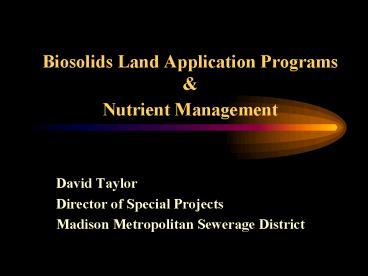Biosolids Land Application Programs - PowerPoint PPT Presentation
1 / 40
Title:
Biosolids Land Application Programs
Description:
Lower risks to human health and environmental quality ... Asparagus. Oatmeal. Ice Cream. Cheese. Biscuits. Bran. Nuts. Corn. Cola drinks. Spinach. Sardines ... – PowerPoint PPT presentation
Number of Views:117
Avg rating:3.0/5.0
Title: Biosolids Land Application Programs
1
Biosolids Land Application ProgramsNutrient
Management
- David Taylor
- Director of Special Projects
- Madison Metropolitan Sewerage District
2
- Biosolids reuse practices
- Quick facts-MMSD
- Nutrient management
- Phosphorus
- MMSD strategy
3
IN WISCONSIN
- 98 of facilities beneficially reuse biosolids
(78 by volume) - 1.2 landfill (10 by volume)
- 0.4 of facilities incinerate (11.5 by volume)
4
WHY LAND APPLY?
- Environmental benefits
- Lower risks to human health and environmental
quality - Public support-both general public and farm
community - Economics
5
Quick Facts About The Metrogro Program
- 40 MGY (9,000 dry tons)
- Field corn is the dominant crop
- Subsurface injection
- N-based application rates
- Voluntary measures to address P
6
Quick Facts About The Metrogro Program
- Privately owned farmland
- Sites approved by DNR
- Land base-55,000 acres
- Apply to 5,000 acres annually
- 17 mile average haul distance
7
(No Transcript)
8
(No Transcript)
9
(No Transcript)
10
(No Transcript)
11
(No Transcript)
12
(No Transcript)
13
Nutrient Management
- Additions should match crop removal
- Soil testing is key
- Historic focus on N
14
(No Transcript)
15
Biosolids N (avail) P205 K20 ratio if
applied at agronomic rateFor MMSD 1
1.5 0.2Typ. Biosolids 1 2.6 0.2
- Soil test N P205 K20 ratio
- For corn 1 0.3 0.2
16
(No Transcript)
17
- P- increasing focus
- Much more challenging issue than N management
- P based application rates not practical
- Conflicting regulatory initiatives
18
(No Transcript)
19
P Sources
- 60 of P from residential sources
- 40 from commercial/industrial sources
20
FOODS HIGH IN PHOSPHORUS INCLUDE
21
Regulatory Initiatives That Have/Will Impact
Phosphorus
- NR 204
- NR 217
- National nutrient standards
- NRCS 590
- Nonpoint Performance Standards
- TMDLs
22
- Group 1 Effluent driven
- NR 217, National Nutrient
- Group 2 Soil driven
- NR 204, NRCS 590, NPPS
- Group 3 Mix
- TMDLs
23
NATIONAL NUTRIENT CRITERIA
NONPOINT REDESIGN
NRCS P APPROACH
NR 217
TMDLs
24
P
25
NR 217 requirements
- Effluent P limits
- 1.0 mg/l chemical
- 1.5 mg/l biological
26
The MMSD Experience
- Pre Post
- NR 217 NR 217
- Effluent P 3.9 mg/l 0.45 mg/l
- Biosolids 2.6 4.5
27
National Nutrient Criteria
- Effluent P limitations well below NR 217
requirements - Increased biosolids P
- Current Future?
- effluent 0.45 mg/l 0.045 mg/l
- biosolids 4.5 5.0
28
TMDL Implications
- Nutrient criteria will become driver for 303(d)
list - Dramatic increase in number of 303(d) listed
segments - Potential major impacts for POTWs
- Effluent
- biosolids
29
- TMDL LA WLA MOS RC
- WHERE
- LA Load from nonpoint sources
- WA Load from point sources
- MOS Margin of safety
- RC Reserve capacity
30
Bottom Line?
- Several regulatory initiatives directed at
nutrients. - Significant impacts on biosolids management
programs. - Integrated approach appears to be lacking.
31
What do we know about P in biosolids?
- Leaching of P generally not a problem
- Lower WEP content in biosolids than commercial P
fertilizer - Bioavailability
32
Figure 1. Comparison of WEP for TSP, manures, and
typical biosolids From OConnor and Elliott 2002
WERF P Project-Draft Executive Summary
33
Figure 2. Comparison of WEP levels for several
biosolids treatment methods From OConnor and
Elliott 2002 WERF P Project-Draft Executive
Summary
34
Biosolids P bioavailability categories relative
to TSP fertilizer-from WERF P Project
35
- Risk management
- PI approach may be an appropriate risk management
tool
36
PI ApproachCritical areas result from high
source of P and high transport
SOURCE
TRANSPORT
37
PI APPROACH
38
NATIONAL NUTRIENT CRITERIA
NRCS P APPROACH
INTEGRATED, COMMON SENSE APPROACH
NONPOINT REDESIGN
TMDLs
39
MMSD Strategy
- Voluntary goal return frequency
- gt 3 years
- Research to achieve 30 reduction in biosolids P
content - Work with LCD to identify high risk sites
40
- Reasonable balance between P applied and crop
removal - Should address surface water issues
- Should allow for a reasonably smooth transition
to a PI approach































